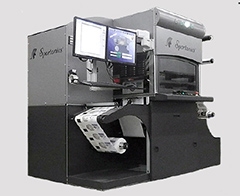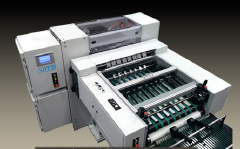On Print | Finishing & Digital Printing
- Published: August 05, 2013, By Dr. Dene Taylor
 High volume digital printer workflows usually differ from those of analog machines, so they are seldom drop-ins to existing operations. For example, a digital press produces books one at a time, each page in sequence and ready for binding, which eliminates cutting and collating but introduces short runs that the traditional bindery doesn’t handle well. Shorter runs can make setup of existing finishing machines longer than run time, so they often become bottlenecks. Or the digital press does not have all the features of the flexographic lines it is to complement, and so there is further purchase or line modification. In getting good ROI for a digital press, not just finishing but also substrate preparation must be part of the total job.
High volume digital printer workflows usually differ from those of analog machines, so they are seldom drop-ins to existing operations. For example, a digital press produces books one at a time, each page in sequence and ready for binding, which eliminates cutting and collating but introduces short runs that the traditional bindery doesn’t handle well. Shorter runs can make setup of existing finishing machines longer than run time, so they often become bottlenecks. Or the digital press does not have all the features of the flexographic lines it is to complement, and so there is further purchase or line modification. In getting good ROI for a digital press, not just finishing but also substrate preparation must be part of the total job.
That is the subject of the second presentation I am giving at the CPP EXPO Conference, jointly sponsored by PFFC, at McCormick Place, September 9 through 11. (The other subjects are "Extended Gamut Printing—Please Your Customers and Go Lean Too" and "Digital Printing for Labels and Packaging.") This article is a just preview. When you attend you will get a lot more detail on options, workflows, equipment, and vendors. And I will be illustrating the discussion with lots of diagrams and photographs—many more than we can fit in here.
![]()
Digital printers in our market use ultraviolet-cure ink, aqueous ink, liquid toner, or dry toner. These can be so different from offset or flexo inks that a great deal of learning is needed to finish them equivalently. There are many output devices comparable to narrow flexo presses (11–13 in.) and a small number that run webs 30 in. wide or print B size sheets. Substrate thickness ranges from less than 0.50–20 mil or more. For completeness, there will be some discussion of product off grand format roll-to-roll and flat bed printers, as well as a few words about Landa Nanography.
Seven finishing-related processes may follow the unwind. (Pretreatment logically belongs here but does not make for a snappy title.)
- Corona is widely used to make plain, lower cost substrates receptive to print or primer. Plasma is another option. Because of their operational simplicity, treaters are mounted on the press, so this value-add step is at the last possible point, helping minimize overall product cost.
- Most primers for UV ink and toner are really print receptive coatings. They ensure adhesion and control ink wetting and dot gain. HP Indigo printers in particular require primed substrates. Many pre-primed substrates are stocked by distributors. The advantages for smaller users are consistency and availability without the cost of learning this special technology. But factories with analog presses usually stock the same basic substrate and can get financial benefit from in-house coating. Direct or offset gravure (flexo) are the preferred applicators, as they are reliable and require minimum attention. All OEMs offer them in-line on most machines. Latex formulations are available for most uses (solvent should be obsolete). They have been optimized for the complete system—substrate, press, ink or toner, subsequent finishing, and final end use. Aqueous inkjet falls into two classes. Many printers are similar to our office or home desk tops. They need paper (or film) with high water capacity so the ink does not bleed or run. It has not proven worthwhile for printers to make these products themselves. However, some offset papers can be printed directly or after a primer has been applied. In one configuration, the Kodak Prosper applies precoats, prints, and overcoats both sides all in-line. Fujifilm’s J Press does something similar with its matched ink and coagulating precoat.
- Overcoating or varnishing the printed substrate is a requirement for many packaging and label applications, primarily for durability and secondly for appearance. For short run custom printing, it can be a major contributor to margin and profit. I have been working with UV technology for many years, and it is my first choice for utility and ease of use. Also, I like the high gloss, again applied with direct or reverse gravure. UV also is used in the minimalist standalone sheet coaters—they tend to be reverse roll and so prone to high coat weight. Most digital presses have clear inks or toners, which can be spot printed to highlight features in the graphic. This is popular with retail items. Building true 3D structures is a special capability that Vince Cahill will discuss in detail at the conference.
- Sheeting also can be done in-line now as well as standalone. In either case, cut length must match print length. With digital timing marks, modern machines can change cut length and start new stacks on the fly. Without immediate change, if cut length changes often, it is best to sheet separately.
 Die-cutting and stripping are essential for label manufacture. Analog die tooling usually has the same diameter as the print cylinder. But digital printing is intended to allow any repeat length, so full rotary tooling is impossible to use. However, by mounting die on a partial cylinder, the label can be cut rotating in register, until the set is cut. The web is then halted, and the tool rotated to the start, whereupon the process starts over. Although step and repeat has very good productivity with mid-size runs of standard format. Unique or very short runs may be better suited to a laser cutter from one of the several vendors.
Die-cutting and stripping are essential for label manufacture. Analog die tooling usually has the same diameter as the print cylinder. But digital printing is intended to allow any repeat length, so full rotary tooling is impossible to use. However, by mounting die on a partial cylinder, the label can be cut rotating in register, until the set is cut. The web is then halted, and the tool rotated to the start, whereupon the process starts over. Although step and repeat has very good productivity with mid-size runs of standard format. Unique or very short runs may be better suited to a laser cutter from one of the several vendors.
 Scoring and die-cutting have been brought in-line for folding carton manufacturing, typically also with overvarnish. Plain stock to finished flat can be remarkably quick.
Scoring and die-cutting have been brought in-line for folding carton manufacturing, typically also with overvarnish. Plain stock to finished flat can be remarkably quick.
- Laminating and trimming are seemingly simple in comparison with die-cutting or special varnishing. Just as with flexographic printing, there are very sound reasons for laminating digital prints in-line. Finally, with sophisticated on-line vision tools, separate rewinding for inspection should be unnecessary. In-line trimming can cut that cord.
Most OEMs of high volume digital printing systems now offer pretreatment, primer, and overvarnishing as standard options, with other processes available for markets like labels. Whether or not a highly integrated line is best for any user is dependent upon the capability in the factory—some benefit greatly and others do better off-line. Yet others have needs that the OEMs do not address, or who have full lines with finishing that digital can be added to, and for them we have a strong group of integrators—innovators who are able to build or assemble systems to combine digital printing with any preparatory and finishing process.
Thank you for reading, and please join us at CPP EXPO this September.
On Print columnist and printing expert Dene Taylor, PhD, founded Specialty Papers & Films Inc. (SPF-Inc.), New Hope, PA, in 2000 for clients seeking consultation for technical management, new product design, development, commercialization, and distribution, as well as locating/managing outsourced manufacturing. Contact him at 215-862-9434; This email address is being protected from spambots. You need JavaScript enabled to view it.; www.spf-inc.com.




